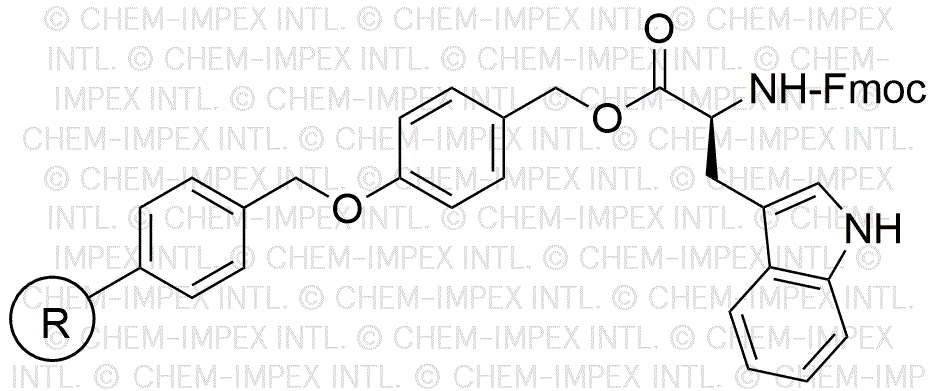Na-Fmoc-L-tryptophan 4-alkoxybenzyl alcohol is widely utilized in research focused on:
- Peptide Synthesis: This compound serves as a protective group in the synthesis of peptides, allowing for selective reactions without unwanted side reactions.
- Drug Development: It is used in the design of novel pharmaceuticals, particularly in creating compounds that target specific biological pathways, enhancing efficacy and reducing side effects.
- Bioconjugation: The chemical is valuable in bioconjugation techniques, facilitating the attachment of biomolecules to surfaces or other molecules, which is crucial in diagnostics and therapeutics.
- Research in Neuroscience: Its derivatives are explored in studies related to neurotransmitter activity, helping researchers understand the role of tryptophan in mood regulation and mental health.
- Material Science: This compound is also investigated for its potential in developing advanced materials, such as drug delivery systems that respond to specific stimuli.
General Information
Properties
Safety and Regulations
Applications
Na-Fmoc-L-tryptophan 4-alkoxybenzyl alcohol is widely utilized in research focused on:
- Peptide Synthesis: This compound serves as a protective group in the synthesis of peptides, allowing for selective reactions without unwanted side reactions.
- Drug Development: It is used in the design of novel pharmaceuticals, particularly in creating compounds that target specific biological pathways, enhancing efficacy and reducing side effects.
- Bioconjugation: The chemical is valuable in bioconjugation techniques, facilitating the attachment of biomolecules to surfaces or other molecules, which is crucial in diagnostics and therapeutics.
- Research in Neuroscience: Its derivatives are explored in studies related to neurotransmitter activity, helping researchers understand the role of tryptophan in mood regulation and mental health.
- Material Science: This compound is also investigated for its potential in developing advanced materials, such as drug delivery systems that respond to specific stimuli.
Documents
Safety Data Sheets (SDS)
The SDS provides comprehensive safety information on handling, storage, and disposal of the product.
Product Specification (PS)
The PS provides a comprehensive breakdown of the product’s properties, including chemical composition, physical state, purity, and storage requirements. It also details acceptable quality ranges and the product's intended applications.
Certificates of Analysis (COA)
Search for Certificates of Analysis (COA) by entering the products Lot Number. Lot and Batch Numbers can be found on a product’s label following the words ‘Lot’ or ‘Batch’.
*Catalog Number
*Lot Number
Certificates Of Origin (COO)
This COO confirms the country where the product was manufactured, and also details the materials and components used in it and whether it is derived from natural, synthetic, or other specific sources. This certificate may be required for customs, trade, and regulatory compliance.
*Catalog Number
*Lot Number
Safety Data Sheets (SDS)
The SDS provides comprehensive safety information on handling, storage, and disposal of the product.
DownloadProduct Specification (PS)
The PS provides a comprehensive breakdown of the product’s properties, including chemical composition, physical state, purity, and storage requirements. It also details acceptable quality ranges and the product's intended applications.
DownloadCertificates of Analysis (COA)
Search for Certificates of Analysis (COA) by entering the products Lot Number. Lot and Batch Numbers can be found on a product’s label following the words ‘Lot’ or ‘Batch’.
*Catalog Number
*Lot Number
Certificates Of Origin (COO)
This COO confirms the country where the product was manufactured, and also details the materials and components used in it and whether it is derived from natural, synthetic, or other specific sources. This certificate may be required for customs, trade, and regulatory compliance.

